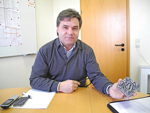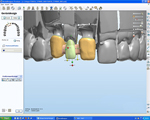1 October 2012
LaserCUSING Takes Denture Production to Industrial Levels
 Dentures produced to the highest quality and at an affordable price, at first glance this seems to be a contradiction in itself.
Dentures produced to the highest quality and at an affordable price, at first glance this seems to be a contradiction in itself.
However, Mannheim based dental laboratory Laufer Zahntechnik GmbH has managed to achieve this fine balancing act with the aid of an entirely new view of the production process. Andreas Laufer, master dental technician and managing director of the company, provides an insight into the tasks and direction of focus of a service company catering for the needs of the modern dental practice.
When it comes to manufacturing dental restorations, the prime conventional techniques are mould-based casting and milling, which is currently the most widely used technique. These manufacturing methods have weaknesses in terms of quality, they take time, but above all tend to be expensive in relation to the unit costs. A milled unit costs approximately 19.90 EUR. According to Laufer, their dental laboratory is able to offer the same unit, manufactured using metal laser melting, at a cost of just 9.90 EUR.
Laser Fusing – The Key to Cost Reduction
Andreas Laufer has been a pioneer of CAD / CAM technology since the latter part of the 1990s, initially in the area of milling. In 2003 his interest was further sparked by generative metal laser melting technology. At the time, this represented an entirely new approach to manufacturing, the benefits of which Laufer recognised early on: "The possibility to move from skilled production using a traditional method to an industrial scale was now achievable," says Andreas Laufer. This technology, which at the time was still in its infancy, promised, thanks to its tool-free manufacturing method, a high degree of efficiency and economic viability taking into account of the costs of employees, material consumption and machine costs. In addition, the time taken to process an order from receipt through to delivery of the product to the dentist has been drastically reduced.
A generative structure also means that less rework is required. Finished products are of the highest quality coupled with high precision, high density and a great fit. A further benefit is the greater freedom of design available when using this technology. Today Laufer works with Concept Laser Mlab cusing, LaserCUSING® machines. Thinking outside of the box and having the courage to focus on manufacturing on an industrial scale has paid off for the company.
Progress on the Learning Curve
 As a pioneer of this technology for dental laboratories, Laufer continually optimised its internal processes and procedures in order to be able to manufacture products as cost effectively as possible. For example, Laufer now manufactures its own build plates for the LaserCUSING® process. "This allows," says Andreas Laufer, "multiple usage with a long life of up to 40 cycles." Further progress was also made thanks to the development of CAMbridge™ software. This program allows for example, automatic support generation and automatic positioning of the crowns and bridges on the build plate. The CAMbridge™ program places the dentures which are to be manufactured into position fully automatically in order to achieve a maximum packing density on the build plate. "Data preparation can be carried out easily and conveniently, saving time and money. The technology has now come of age. Today a dental laboratory can successfully complete the necessary initial training on how to use this CAD/CAM technology within just a few weeks," says Andreas Laufer.
As a pioneer of this technology for dental laboratories, Laufer continually optimised its internal processes and procedures in order to be able to manufacture products as cost effectively as possible. For example, Laufer now manufactures its own build plates for the LaserCUSING® process. "This allows," says Andreas Laufer, "multiple usage with a long life of up to 40 cycles." Further progress was also made thanks to the development of CAMbridge™ software. This program allows for example, automatic support generation and automatic positioning of the crowns and bridges on the build plate. The CAMbridge™ program places the dentures which are to be manufactured into position fully automatically in order to achieve a maximum packing density on the build plate. "Data preparation can be carried out easily and conveniently, saving time and money. The technology has now come of age. Today a dental laboratory can successfully complete the necessary initial training on how to use this CAD/CAM technology within just a few weeks," says Andreas Laufer.
Paradigm Shift to Industrial Fabrication
The switchover to LaserCUSING® paid off for Laufer, whose aim, from the outset, was to transform traditional artisan fabrication into industrial production. With fully automatic generative fabrication, on average 80 units are produced simultaneously on one build plate each day. The enormous cost advantages of this method lie in the batch size, and the automatic fabrication overnight which not only speeds up the technical production time itself, but also offers an enormous saving in terms of time for dentists as service partners: They can take an impression of the patient in the morning and send it to the laboratory. At Laufer the associated plaster-cast model is then created and scanned in, and the denture is designed.
Towards the end of the working day, the build job, prepared using CAMbridge™ is started on the Mlab cusing machine. Fabrication then takes place fully automatically overnight. The next morning the denture parts are heat treated and then detached from the build plate. There is then a minimum of re-work on the individual items, involving breaking off the support structures by hand and finishing the denture by hand. After approx. 2-3 minutes, the denture is ready to be dispatched or can have a veneer applied when further work is carried out in-house. Dentists and patients really appreciate this time saving procedure: Within the space of just two days, dentists can insert the dentures into the mouths of their patients providing a greater quality of life, thanks to the quality and time saving on offer.
Looking to the Future
The achievements to date at Laufer have demonstrated that it is possible to deliver high quality coupled with high speed. However, Laufer also see lots of other opportunities for improving the production process.
The central point here is to generate the data via a "mouth scan" performed at the dentist's premises, followed by printing of a plastic model. Why, according to Laufer, should it not be possible to replace the traditional plaster-cast model with a printed plastic model? This would allow two pieces of work to be carried out in parallel: The printing of the model to check the fit and the construction of the denture. "This would make the processing of orders even faster," says Laufer, "scan in the morning and then fit the denture the very next day – simply 'overnight' production." Laufer sees important changes on the horizon with materials too. Instead of finishing a metallic base with ceramic, as has previously been the case, it will be possible in future to employ high-strength full-plastic solutions whose processing will then also take place using generative means, with laser fusing. Laufer seems to have a number of other ideas for the future. The route that has been followed, from process optimisation, improvement of the production process and the industrial approach on the basis of generative fabrication, demonstrate a clear path of growth. Laufer's range of customers now includes around 500 dental practices.
The full range of Concept Laser LaserCUSING® machines, including the Mlab cusing featured in this article, are available from ES Technology Limited who are responsible for the marketing, sales, service and support of Concept Laser products within the United Kingdom and Ireland.
ES Technology recently launched its demonstration facility to show Additive Manufacturing at its most advanced with the new Concept Laser Mlab cusing machine. Companies are invited to contact ES to arrange a visit to the facility in Daventry to see the Mlab cusing machine in action and discuss potential applications.
- Contact Information
- Name: Colin Cater
- Email: c.cater@estechnology.co.uk
- Website: www.estechnology.co.uk

